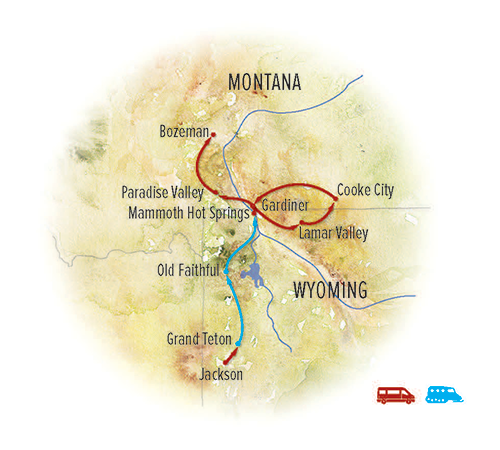Itinerary
Day 1: Jackson, Wyoming
Our Yellowstone wildlife tour begins in the Old West town of Jackson, which sits at the edge of Grand Teton National Park in the shadow of the mountain range’s jagged spires. This evening, meet your Expedition Leader and fellow adventurers at an informal welcome dinner and orientation.
Day 2: Jackson Hole—National Elk Refuge
Our winter safari begins in the broad valley of Jackson Hole as we look for bald and golden eagles, bighorn sheep, coyote, bison, mule deer, moose and elk. After lunch at the National Museum of Wildlife Art in Jackson, travel by horse-drawn sleigh through the National Elk Refuge. Gliding over the snow that blankets the valley floor, we capture close-up photos of the massive herd that winters here, with thousands of animals roaming the range.
Day 3: Grand Teton National Park / Yellowstone National Park—Snowcoach Tour to Old Faithful
A traverse of Grand Teton National Park offers a panorama of the iconic peaks rising above the Snake River.. Reaching the boundary of Yellowstone, we board heated snowcoaches that convey us into the pristine winter splendor of America's first national park. We stop at West Thumb Geyser Basin on the edge of Yellowstone Lake, looking along the way for moose, river otters and trumpeter swans before arriving at Old Faithful Snow Lodge. Because winter access to the park's interior is limited to snow vehicles, an overnight stay here is a coveted experience. In silent seclusion, witness the park's most famous geothermal feature, Old Faithful geyser, erupt in a crystalline veil of spray. And on a clear night, we may even get to watch it shoot skyward by the light of the moon.
Day 4: Mammoth Hot Springs / Northern Range Wolf Tracking
Back aboard the snowcoach, head north through Yellowstone’s famous geyser basins to reach the white limestone terraces of Mammoth Hot Springs this afternoon, where we often see many elk. Here, thermal water spills over travertine terraces that have been described as a “cave turned inside out,” with heat-loving organisms called thermophiles adding distinct colors to the mineral-laden formations. As dusk descends, an early-evening drive through the Northern Range on the park's north perimeter offers a good chance to see bison, their shaggy coats encrusted with ice, and our first chance to search for wolves.
Even though they are almost always seen at a distance (and brought in closer via high-powered spotting scopes), Yellowstone's northern tier is the best place in the world to find these charismatic predators, and we dedicate the next two days to searching for them, among other more-abundant park wildlife. Although pack movements are unpredictable, and the impact of past human interactions tends to make wolves shy in the presence of humans, our Expedition Leader is an experienced tracker, teaching us about wolf behavior and how to look for them through the scopes we carry on board our vehicles. We are also in close contact with scientists who conduct research on wolves in the region, and they will help us locate them based on recent sightings. At the end of an exhilarating day, we head to our hotel near the northern boundary of the park where we spend the next two nights.
Day 5: Northern Range & Lamar Valley Wolf Safari / Cooke City—Private Gallery Visit
A full day is ours to scout for Yellowstone's legendary wolves and other wildlife. Reintroduced to the park in 1995 amid much controversy, the gray wolf was returned to this native ecosystem after a 70-year absence following a policy of government-sanctioned eradication. Since then, they have flourished, supported by bountiful prey including a multitude of elk. Yet much rancor continues to surround their presence, and we learn in detail from our guides about the current conditions in which wolves exist within the greater Yellowstone area. As the wolves have restored more balance to the natural ecosystem, elk numbers have dropped, and we may not be as likely to see as many wolves as visitors did several years ago. If we are especially lucky, though, we might see a pack test an elk herd for a weak or sick animal, or spot lone individuals foraging on their own. But even if the wolves remain elusive, the winter landscape is magical, and we're sure to see plenty of other wildlife native to the park.
Day 6: Lamar Valley Wolf Tracking / Paradise Valley / Bozeman
As dawn illumines the snowy meadows of the Lamar Valley and the peaks of the Northern Range, we return once more in search of wolves. If we are fortunate to sight them, our onboard spotting scope enhances our observation of their activities from a distance without disturbing their natural behavior. Many of our Expedition Leaders have worked for years with the field researchers who track these wolves daily, and together they provide us every opportunity to find these intriguing animals in their natural surroundings. Returning to Mammoth Hot Springs and exiting the park once more, we leave Yellowstone’s frozen silence and continue up the Paradise Valley along the Yellowstone River, flanked by the Absaroka and Gallatin ranges on either side. Reaching Bozeman for a final night, we gather for a farewell dinner this evening.
Day 7: Bozeman / Depart
If your flight schedule permits, you may enjoy exploring Bozeman on your own today. This historic Old West/New West town, with a rich mining and trapping heritage, boasts 40 individual properties on the National Register of Historic Places. It is home to Montana State University, with a thriving contemporary economy built on growing tourism and tech sectors. With a wide range of cultural and outdoor activities, Bozeman offers plenty to do. A transfer to the airport is included to meet your departing flight.
Physical Rating: Easy to Moderate
Natural Habitat Adventures is an authorized permittee of Grand Teton and Yellowstone national parks.
























